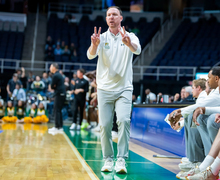Joint education program sees minimal interest in first semester
With little information available and released late last semester, the School of Education’s new joint bachelor’s/master’s degree program has seen minimal interest from students.
Having not published information on the new program until April, the School of Education hopes to see the program’s six-student enrollment increase over time. Some who are enrolled said the main issue with the program is the little information available on it.
‘It’s not going to be huge,’ said School of Education Dean Douglas Biklen. ‘Our biggest programs are ones students enter either in the freshman year and sophomore year.’
The joint degree program officially began this fall term to aid those who realize they want to be teachers after their freshman and sophomore years. Students can earn a bachelor’s degree from the College of Arts and Sciences and a master’s degree in teaching in less time than it would take to do each separately or even dually.
Biklen said the number of students enrolled is on par with what was expected. He said he hopes the number will eventually double or triple, but remain small.
‘You can do our traditional dual program — we’ve had students start as late as the sophomore year and fit it all in — but I think some of those people might look at this and say, ‘Yeah, but I can have more flexibility and not be as crazy or stressed if I do the extra time and get the master’s at the end,” said Marie Sarno, program specialist for the School of Education, in April.
Students who transfer into the program can now complete it without having to worry as much about finishing on time, she said.
That’s not to say there isn’t a deadline to transfer for those who want to graduate on time. Sarno said the prime window for enrollment was between a student’s fall semester of sophomore year to the spring semester of junior year.
For most juniors and seniors, like senior math major Tanil Russo, the requirements are too great to be accomplished at that late stage in the typical four-year college time period.
Russo transferred to SU from the State University of New York Purchase last fall and enrolled in the program before the fall 2010 semester. But she had to drop out of it once the term started because she could not fit all the required courses in. So instead, Russo is going to graduate this May with a degree in math and apply for a teaching assistant job at SU.
Russo said she would still recommend the program.
‘I do recommend it to people because it saves you time, it saves you money, and if you’re willing to do a little extra work in your undergrad, then you have a whole less year of graduate school,’ Russo said.
Plus, Russo said, if she could have done the program, she would have known, for certain, where she’d be attending graduate school, and she wouldn’t have had to reapply for admission.
Russo’s only complaint is the lack of knowledge around campus in regard to the new program, particularly among the faculty.
Russo’s math advisor didn’t know the requirements for the math education program because it was a new five-year program, Russo said.
Russo added Sarno was really the only one who knew the ins and outs of the program. Everyone else had to ask her for details.
Biklen said he agrees the school put out information on the program late in the year — it wasn’t even advertised in admissions materials — but he said SU will now be promoting the program every year.
As for an evaluation of the program so far, Biklen said it’s too early to tell. The program is only a month old, and a lot remains to be seen before judgments or changes can be made.
‘We really have to get some experience with it and see how it works,’ he said. ‘Usually when you start something new, there are unintended consequences, so you kind of wait to see how things shake out.’
Published on September 15, 2010 at 12:00 pm
Contact Lorne: lefulton@syr.edu





